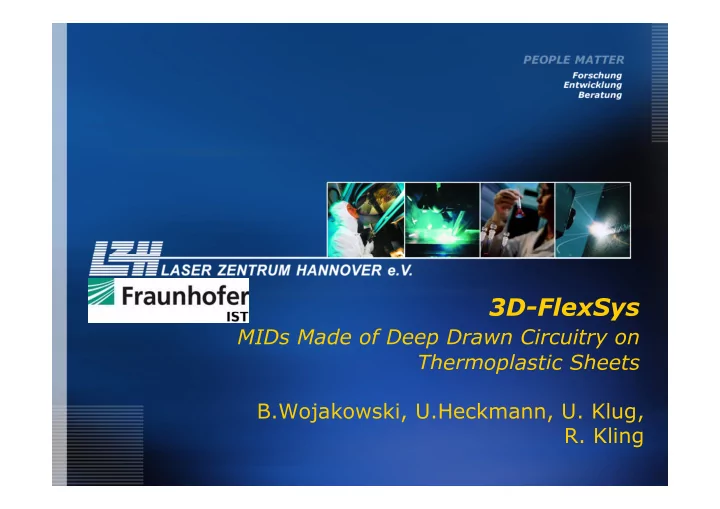

3D-FlexSys 3D FlexSys MIDs Made of Deep Drawn Circuitry on Thermoplastic Sheets e op ast c S eets B.Wojakowski, U.Heckmann, U. Klug, R. Kling l
Outline • Motivation • Process Chain • Process Chain – PVD-Metallization – Deep Drawing D D i – Laser Structuring – Plating Pl i • Conclusion • Outlook
Motivation Problem Usually MID components are manufactured in Usually MID components are manufactured in three dimensional processes. Thus advantages in efficiency of a two dimensional process are sacrificed. Solution So u o Manufacturing of 3D-MIDs using a combination of a number of standard 2D- procedures . The transition to a 3D shape is d Th t iti t 3D h i done at the end of the process chain
Motivation Goal - Deep-drawable MIDs made of thermoplast Deep drawable MIDs made of thermoplast foil substrates - Cost efficient low vacuum PVD metallization Cost efficient low vacuum PVD metallization - High speed 2D laser structuring of the metallization to generate stretchable g circuitry - Plating of the metallization to increase the conductance
Process Chain
Process Chain Process Chain PVD-Metallization • Magnetron sputtering sputtering • Coarse pre- structuring structuring using a shadow mask shadow-mask Shadow-mask outline
Process Chain Process Chain PVD-Metallization • Connecting layer of 50 nm chromium – Improves adhesion • Conductive layer of 1 µm copper Copper Copper Chromium Thermoplast Thermoplast Coating sketch g Coated polystyrene
Process Chain Process Chain Deep Drawing • Heating of the substrate • Blowing of a primary extrusion • Forming by a mechanical tool Drawing tool and drawn PS Drawing tool and drawn PS
Process Chain Process Chain Deep Drawing • Untreated metallization is too rigid to withstand the mechanical stress during deep stress during deep drawing • Cracks • Cracks • Loss of conductivity 1000 µm D Drawn copper coating on a i polystyrene substrate
Process Chain Process Chain Laser Structuring • LUMERA Rapid – 532 nm – 12 ps • Coherent AVIA – 355 nm – 20 ns • Galvanometric scanner • Air bearing stages Ai b i t Laser treatment setup
Process Chain Process Chain Laser Structuring First approach 100 µm • Simple meander cuts • Simple meander cuts • Seen here: Additional removal of surplus material Laser structured copper on PC d C
Process Chain Process Chain Laser Structuring 100 µm • Small structures are withstanding the mechanical stress of deep drawing mechanical stress of deep drawing – Structure widths below 40 µm Polycarbonate • Bigger structures crack at the pivot Bigger structures crack at the pivot points of the meander • Structures conductive on polycarbonate 100 µm P l Polystyrene t
Process Chain Process Chain Laser Structuring • Added complexity • Computer generated • Computer generated 500 µm m geometry • Shortened overall length • Works only on y polycarbonate 100 µm Laser structured copper on PC pp
Process Chain Process Chain Laser Structuring 500 µm • Added redundancy • Suited to orthogonal • Suited to orthogonal stress • 80% increase in length achieved Laser structured copper on PC Laser structured copper on PC
Process Chain Process Chain Laser Structuring • Very complex net 1 mm structures • Added redundancy • Suited to orthogonal g stress Laser structured copper on Laser structured copper on polycarbonate
Process Chain Process Chain Laser Structuring • Very complex net 1 mm structures • Added redundancy • Suited to orthogonal g stress • Works also on polystyrene Laser structured copper on polystyrene
Process Chain Process Chain Plating Electroless plating • Increasing layer • Increasing layer thickness to a usable level • Curing of very small cracks • Possible on polystyrene and ABS substrates b t t Electroless plated copper on polystyrene and ABS polystyrene and ABS
Process Chain Process Chain Plating Electro-plating • Fast growing • Fast growing material thickness • Needs full conductivity • Works on polycarbonate Electro plated copper on • Tests on polystyrene polycarbonate polycarbonate not concluded yet
Conclusion • Manufacturing method for MIDs – Mostly two- dimensional • Proof of principle • Further improvement necessary
Outlook • Building a demonstrating application application • Developing a machine concept p g p • Refining the process • Developing add-on processes D l i dd
Thank You! Laser Zentrum Hannover e.V. Fraunhofer-IST Mikrotechnik Sensorische Funktionsschichten Se so sc e u t o ssc c te Hollerithallee 8 Bienroder Weg 54 E 30419 Hannover 38108 Braunschweig M. Sc. Bodo Wojakowski M Sc Bodo Wojako ski Dipl.-Ing. Ulrike Heckmann Di l I Ul ik H k Tel.: +49 (0)511 2788-278 Tel.: +49 (531) 2155 - 581 Email: b.wojakowski@lzh.de Email: ulrike.heckmann@ist.fraunhofer.de
Recommend
More recommend